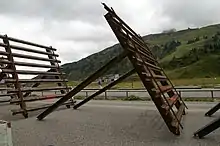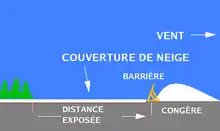_-widok_ze_schroniska_na_wysoko%C5%9Bci_3029_m_n.p.m_-_panoramio.jpg.webp)

A snow fence, similar to a sand fence, is a barrier that forces windblown, drifting snow to accumulate in a desired place. They are primarily employed to minimize the amount of snowdrift on roadways and railways. Farmers and ranchers use snow fences to create drifts in basins for a ready supply of water in the spring.[1] Ski resorts also use snow fences in order to increase snow depth in specified areas, or for avalanche control.
Description and physical mechanism

_on_the_Piibe_highway_in_Estonia_(December_2022).jpg.webp)
Temporary snow fences are usually one of two varieties: perforated orange plastic sheeting attached to stakes at regular intervals (the type usually used for construction site fencing or temporary sports field fencing), or a cedar or other lightweight wood strip and wire fence, also attached to metal stakes. A permanent snow fence usually consists of poles with horizontal planks running across them so that they cover just over one-half of the total fence area. The bottom 10% to 15% of the fence should be left open so that snow does not settle directly under the fence, which would reduce its effective height. Taller fences trap more snow. Taking the height of the fence as one unit, it should be placed thirty-five units or more to windward of the road or building that it is meant to protect.[2] Permanent snow fences can also consist of lines of closely spaced shrubs, conifer trees or maize stalks.[3][4]
Snow fences work by causing turbulence in the wind, such that it drops much of its snow load on the lee side of the fence. Thus, snow fences actually cause snow drifts, rather than preventing them. The fences are placed so as to cause snow to drift where it is beneficial, or not harmful so that the snow does not drift onto undesired areas such as roads or among buildings.
Snow fences have been reported to save lives and reduce maintenance costs. Snow and ice removal and control costs over $2 billion annually in the US.[5] Studies published by Strategic Highway Research Program (SHRP) of National Research Council in 1991 showed that mechanical snow removal costs about 100 times more than trapping snow with fences.
Snow fences can also be used to trap tumbleweeds.
In Japan

In Tohoku and Hokkaido of Japan, especially in areas with strong wind and snow such as the coastal areas of the Sea of Japan and the plains, structures that lead to snow fences called "Yukigakoi" made of reeds, chives, and wooden boards have been made for a long time. Even now, the culture of making "Yukigakoi" can be seen in some areas such as Hokkaido.[6]
As for transportation facilities, wooden fences made on railway lines in the 1880s as a measure against snowstorms began. However, at the beginning, it was difficult to predict where the snowdrift would be formed, and it was not possible to control the snowdrift well, and there was also a fire accident caused by the sparks generated from the steam locomotive due to the wooden structure, so it was unpopular. It is said that it has replaced the Railroad snow forest in Japan as well.[6][7]
On the other hand, for roads, a structure called a "Blowing pool type snow fence" was studied and installed for the first time in 1961, referring to the wooden Snow fence used all over the world. Then, in 1967, the Hokkaido Regional Development Bureau Construction machinery workshop (at that time) developed a "Blow-off snow fence" that began to be installed on national roads in 1969, and later the Hokkaido Development Civil Engineering Research Institute (Currently, Public Works Research Institute Cold Region Civil Engineering Research Institute) researched "Blow-up prevention type snow fence" and installed it in 1978, and further applied "Blow-up prevention type snow fence" to "Blowing-proof snow fence" from 1981 and since 1988. It came to be installed.[6][7]
In recent Japanese railways, "Blowing pool type snow fence" and "Blowing-proof snow fence" have been re-evaluated for their usefulness based on the research results and achievements on the road, so they will be used again as railway snow protection measures. [8]
See also
- Snow guard, a device attached to roofs to prevent snow from falling on people below
- Snow shed, which is designed so that snow collects on top
References
- ↑ Jairell, R; Schmidt, R (1999), "133", Snow Management and Windbreaks, Range Beef Cow Symposium, University of Nebraska - Lincoln, p. 12
- ↑ Iowa's Cooperative Snow Fence Program (PDF). Des Moines, Iowa: Iowa Department of Transportation. June 2005. p. 11.
- ↑ "Living Snow Fences: Functions and Benefits" (PDF). University of Minnesota. 2011. Retrieved 14 November 2014.
- ↑ Nixon, Wilfrid; Davison, Megan; Kochumman, George (November 2006), Living Snow Fences (PDF), University of Iowa, retrieved 14 November 2014
- ↑ Blackburn, Robert R. (2004-01-01). Snow and Ice Control: Guidelines for Materials and Methods. Transportation Research Board. ISBN 9780309087995.
- 1 2 3 Takeuchi Masao (April 10, 2003). Journal of the Japanese Society of Snow and Ice "SEPPYOU" Volume 65, Issue 3: For the control of blowing snow (5) - Technical development in use of snow - fences - (in Japanese). Yukiken Snow Eaters Co., Ltd.
- 1 2 Public Works Research Institute Cold Region Civil Engineering Research Institute. Part 3 Snow fence (PDF) (in Japanese). Public Works Research Institute Cold Region Civil Engineering Research Institute.
- ↑ Tsutsumi Takuya; Tsutsumi Takuya (March 2018). Verification and improvement of snow control performance of windbreak fence (PDF) (in Japanese). Building Research Department Local Independent Administrative Agency Hokkaido Research Organization.
External links
- The short film Effective Snow Fences is available for free viewing and download at the Internet Archive.
- Plan for a 3 meter Wyoming-style snow fence.
- Plan for a 3.6 meter Wyoming-style snow fence.
- "What’s That Thing: Roadside Fence Edition", by Mark Vanhoenacker, Slate, Aug. 1, 2013
- Snow fences: do they still serve a purpose?
- Building effective Snow Fences – Better than a good idea